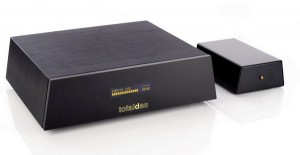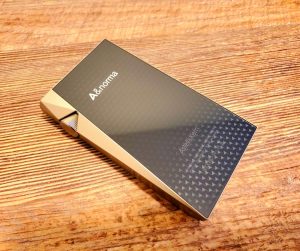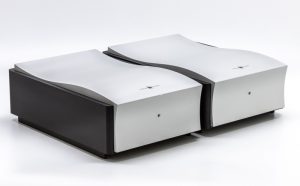"Shine on you crazy diamond"
- by Pink Floyd
First of all, I should say that I like the Simaudio MOON Neo 280D ($2200) very much and that, with the optional MiND module, it provides for a one-box media server solution, WiFi support, DSD256-capable DAC, and all. Having said that, I did run into a few bumps that I never encountered with the Aurender N100H, and I do think that the USB input on the Ayre DX-5 DSD "A/V engine" sounds a bit more open even in the context of a lesser system. However, to be fair to the 280D, it costs about the same as the Aurender N100H alone, pretty much even with the MiND module that connects to your LAN, and the DX-5 DSD adds an additional $10,000 to the original retail price, not mention about $1000 for the Stealth USB cable I put between the N100H and the DX-5 DSD. I did run in the 280D with an 11" MacBook Air, putting iTunes on repeat for about two weeks, and using the much less costly (and no longer made) Locus Design Polestar USB cable, because I knew the Polestar would add little coloration of its own. I need to make it very clear that the 280D always performed very admirably and, if not for the existence of the Aurender N10—which could contain my entire CD library and then some as well as provide TIDAL support via S/PDIF for my Audio Note DAC 4.1x Balanced Signature—I probably would have asked to keep the 280D and made it part of my main system. It sounded that musical. However, I can only put so many things on my supplemental Quadraspire SVT stand, I was already using a very long DH Labs Silver Sonic Power Plus AC cable and a second-hand Chang Lightspeed CLS-505 to supply power to the SVT stand (bypassing my main Equi=Tech balanced transformer in the process), and I had a Nakamichi CR-3A three-head cassette deck on the way because I am kind of into tape, which is another story.
Because my cable modem is very far from my main system and I wanted gigabit Ethernet going to the 280D, I did not even attempt to run a 70-100 foot CAT 7 Ethernet path cable from the back of my bedroom to the front of my living room. Rather, I got my third Apple AirPort Extreme along with a three-meter AudioQuest Forest Ethernet patch cable and created a new, high-speed, wireless node on my home network, which I plugged into the 280D to at least bootstrap the MiND module into its own Wi-Fi mode. However, my initial listening was done with the MacBook Air via USB and TIDAL via the AirPort Extreme/AQ Forest combination, and that was fine. When I mentioned to a friend that I thought the 280D sounded better than my old Berkeley Alpha Series 2 personal reference DAC, he said that might be more of a task for the 380D, at more than twice the price of the 280D. If you're talking about resolution alone, that could be true. I can't really say because I never heard the 380D although the 280D could, at times, sound a little occluded. However, I was talking about overall musicality and was quite delighted that unlike many less expensive DACs (I mean in the $2,000-$3,000 range), the 280D never sounded overly etched or detailed, felt solidly built, and looked beautiful in mostly black with gold trim sitting on my bamboo and aluminum SVT stand. In other words, the Neo 280D reeked of quality. I did run into one odd problem with it, which I attribute more to incompetence on my part than anything to do with the 280D, which was that I paused my iTunes continuous loop, left the 280D sitting on for several days with no source playing, then attempted to switch it over to TIDAL via the MiND on my iPad Mini. It worked and, for the most part sounded lovely, but the DSD128 light kept flashing and I would get a somewhat frequent breaking up of the sound until I powered down the 280D and powered it back up in USB mode, playing Bach's Saint Matthew's Passion at 24/192 as downloaded from Channel Classics. After that, I didn't appear to have any more problems, and I was still using the AirPort Extreme for my gigabit Wi-Fi connection. So it wasn't what I would call a fair test of the 280D and its MiND module.
Since I don't have a UPnP-capable NAS cluster (I actually sold mine to an audiophile friend for 1/2 retail), I had to rely on some free server software for my iMac made by dbpoweramp, and that had its own weird problems. When I first downloaded and set it up, it scanned my Fusion drive, found all the music, and made some mental note of it, because when I ran the server—which, oddly, caused its installation icon to stay on my desktop--I could see the server in the MiND App and even drill down to the level of individual albums with cover art, but I could not get the music to play. It would not, "engage", to quote Captain Jean-Luc Picard of the Starship Enterprise. Lionel at Simaudio suggested I update the 280D's firmware, but I thought I might have had an operator error with the server software, so I set that thought aside for awhile while I did a little more research and got a suggestion for another UPnP server for my iMac from a friend. I wish I could say that the new server software fixed the problem, but I don't know because I haven't tried it yet. In fact, I am still listening to Saint Matthew's Passion at 24/192 PCM while I have written everything you have read so far on my iPad Mini using Apple's Pages and iCloud. Ain't technology great? I am now about to switch over to TIDAL using the MiND App while lying on my couch, and the verdict is... it works, with no distortion whatsoever and may actually sound better, at 16/44.1 coming off of the Internet than Bach did at 24/192 coming from Audirvana Plus off of my MacBook Air and its flash memory. I must try another USB cable, quite possibly my slightly outdated Synergistic Research Active SE USB cable with its Galileo MPC and either the gray or silver Enigma Tuning Bullet. Just FYI, the classical album I choose to stream from TIDAL (the MiND App giving you slightly more information about what you're streaming than the Aurender Conductor App even if you have to kickstart the 280D once in a while) was Max Richter's from Sleep on DG with the very appropriate picture of the Earth's "MOON" as the cover art.
By searching for "dbpoweramp UPnP" on the web, I came across the documentation page for the original server I was trying to use, named Asset. Although it does not explicitly state it in the instructions, you need to manually copy and paste Asset from its installation dialog to the OS X Applications folder, at which point OS X will recognize it as an application and let you run it properly, including ejecting the installer. Once I had done all of that, the 280D would play CD-resolution albums via my Airport Extreme from my iMac without any problems at all, and sound excellent in doing so. When I tried to play a 24 bit / 192 kHz album over gigabit Wi-Fi though, at least using the Airport Extreme, the whole thing just stalled and, again, I could not get the music to, "engage". At that point, I decided to order a 100 foot "slim" Cat 7 Ethernet patch cable that I found on Amazon for $37.95, just in case. I hired someone through TaskRabbit to come over and run the cable from the Apple AirPort Extreme in my bedroom to my Magnum Dynalab internet tuner in the stereo stand at the front of the living room. It was a very long run. However, I heard an immediate improvement in the quality of the sound compared to using Wi-Fi and dropouts or momentary periods of silence during buffering almost completely disappeared. I connected the very long Cat 7 patch cable into the MiND module on the Neo 280D and started to experiment listening to files served by dbpoweramp's Asset UPnP software on my iMac as well as TIDAL Hi-Fi, all controlled by Simaudio's own MiND App for the iPad. The setup worked almost flawlessly and sounded very good. I only ran into one problem, which is that I just couldn't seem to play files above 24/96 even though the Neo 280D goes up to at least 24/192 and can play up to DSD256 as well (it depends on whether you're using the MiND module or a USB connection). Also, I should note that the 280D plays native DSD files and does not rely on a DSD over PCM connection.
I called someone in the technical support department at Simaudio and he explained the problem was the filetype. I have pretty much all of my music in either ALAC or AIFF because I built my original library around iTunes even though I now use other software. As it turns out, the MiND module won't play anything but FLAC files above 24/96 for reasons related to where the lossless files get decompressed. That would be a real bummer if I had a large collection of 24/176.4 or 24/192 files in ALAC, but I really only have a few. So I just need to convert them to FLAC in an application like XLD and then the Neo 280D should be able to play files up to 24/192 (or single DSD) over my home network. To get double DSD, I would need to use a USB connection. I should also mention that, although I didn't try it, the Wi-Fi section of the MiND module can only go up to 24/88.2 regardless of how fast your wireless network is. The sound is really very good, perhaps just a tiny bit harsh in the extremes of the treble. Since I plan to put a second AirPort Extreme at the end the 100 foot Cat 7 cable to act as a network extender and to split the feed to both my internet tuner and to the Neo 280D via AudioQuest Forest Ethernet cables, I may get better sound. Plus, there's also the possibility of replacing the 100 foot copper cable with optical fiber, although that requires converter boxes and power supplies at both ends so it may not be worth the hassle. I would say that if you really want play very high resolution files through the 280D, it makes sense to just a computer into via a good USB cable. However, if you plan to listen to mostly TIDAL Hi-Fi or CD rips, you should really have no problem at all. Plus, like I said, the MiND module will let you go up to 24/192 as long as any files above 24/96 are in the FLAC format. I think it's time to change my default hdtracks.com file-type setting!
I thought that I owned the 24/176.4 download of Time Out by The Dave Brubeck Quartet but I couldn't find it anywhere so I purchased it, possibly for the second time, in the FLAC file format and put in one of the directories that Asset scans. I had tried to convert some high-resolution ALAC files to FLAC in an application called Switch, but it didn't carry over the metadata or cover art, so I need to try XLD. There's also Max but that stopped working for me a long time ago. Unfortunately Pure Music only goes the other way (from FLAC to ALAC). In any case, I had Asset rescan the directories with music that I want in them to be sure to pick up Time Out. I have the 24/176.4 version of Time Out playing now and it sounds really great, truly a music and audiophile classic. I think that FLAC sounds better than ALAC or AIFF, which doesn't really make sense because both ALAC and FLAC use lossless compression and AIFF is totally uncompressed, but high-end audio seems to be full of mysteries that defy the laws of physics, so I will say that I have no problem purchasing downloads in FLAC from now on, particularly since I no longer use iTunes as my music storage database even when I am playing files directly from my computer. Then I use Audirvana Plus and its library manager which both sounds better and has more useful features than iTunes even if it is a big less slick.
Another feature I discovered in the MiND App is the ability to access radio stations through vTuner. I really enjoyed this. I have a Magnum Dynalab MG-807T internet runner that sounds very good particularly given its all tube triode output stage, but can't received HD radio broadcasts, which the 280D can, and it really doesn't offer practically remote control. I hate to sound lazy, but I often listen to internet radio late at night, and it really is awfully nice to change stations using the MiND iPad App. I haven't decided yet, but I may let go of the MD-807T and put the 280D in its place because it does so many things so well. I still have the Aurender N100H going into my Ayre DX-5 DSD through a stealth USB cable in my two-channel home theater system. I think that sounds slightly better than the 280D with MiND module but it is difficult to tell because we are talking about two very different system with the home theater system being much more forgiving, and the N100H/Stealth USB/DX-5 DSD combination cost a whole lot more than the 280D with the MiND module. A fairer comparison would be the 380D with the MiND module, but I am already really very happy with the 280D, so much so that I decided to keep it as my current streaming solution for the main system.
In fact, early this morning I moved the Magnum Dynalab MD-807T onto the auxiliary rack and plugged the 280D directly into the TUNER input of my Audio Note OTO using an Audio Note AN-Vx interconnect with Eichmann Silver Bullet Plugs. Having the better interconnect and the direct connection to the OTO going through pure silver cable rather connecting the 280D indirectly through the Skipjack and about twenty feet of lesser but still very good copper cable, not to mention connecting the 280D directly into my Equi=Tech balanced transformer via a Stealth Swift power cable rather than going through the Chang Lightspeed and DH Labs Silver Sonic Power Plus really opened up the sound of the 280D, so much so that I think it could use a little additional run in and the thought of upgrading to a 380D has kind of evaporated from my mind. I will likely let go of MD-807T despite missing it's sweet tube lushness and use the 280D as my universal high-end streaming appliance, relegating tape decks and my second AirPort Extreme to the auxiliary rack. In the spirit of listening to Internet radio, I used the vTuner option in the MiND App and navigated my way to BBC Radio 3. I needed to turn the volume up quite a bit in comparison to streaming from the fixed drive on my iMac and I did hear a certain sharpness to the sound that the MD807T did not share. However, I am quite certain that the 280D sounds more detailed and has a more silent background. So it's a trade off. I may keep the MD-807T. I may let it go. However, I am very happy with the 280D and cannot imagine my system without it for all the things it does so well. I think that about wraps things up.
Kindest regards,
Andy
Simaudio








































